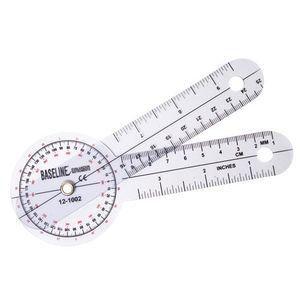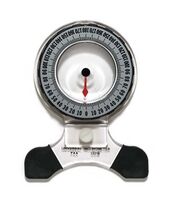Range of Motion: Difference between revisions
No edit summary |
No edit summary |
||
| Line 23: | Line 23: | ||
Tape measures can also be used to measure range of motion in some specific parts of the body (lumbar range of motion). | Tape measures can also be used to measure range of motion in some specific parts of the body (lumbar range of motion). | ||
== Range of | == Range of Motion Exercises == | ||
Range of motion exercise refers to activity aimed at improving movement of a specific joint. This motion is influenced by several structures: configuration of bone surfaces within the joint, joint capsule, ligaments, tendons, and muscles acting on the joint. | Range of motion exercise refers to activity aimed at improving movement of a specific joint. This motion is influenced by several structures: configuration of bone surfaces within the joint, joint capsule, ligaments, tendons, and muscles acting on the joint. | ||
There are three types of range of motion exercises | There are three types of range of motion exercises | ||
# Passive range of motion: Movement applied to a joint solely by another person or persons or a passive motion machine. When passive range of motion is applied, the joint of an individual receiving exercise is completely relaxed while the outside force moves the body part, such as a leg or arm, throughout the available range. | |||
# Active range of motion: Movement of a joint provided entirely by the individual performing the exercise. In this case, there is no outside force aiding in the movement. | |||
# Active assist range of motion: Joint receives partial assistance from an outside force. This range of motion may result from the majority of motion applied by an exerciser or by the person or persons assisting the individual. It also may be a half-and-half effort on the joint from each source. | |||
== | == Range of Motion Chart == | ||
{| class="wikitable" | |||
|'''Joint/Segment''' | |||
== | |'''Movement''' | ||
|'''Degrees''' | |||
|- | |||
| rowspan="2" |Elbow | |||
|Flexion | |||
|140 | |||
|- | |||
|Hyperextension | |||
|0 | |||
|- | |||
| rowspan="2" |Forearm | |||
|Pronation | |||
|80 | |||
|- | |||
|Supination | |||
|80 | |||
|- | |||
| rowspan="4" |Wrist | |||
|Extension (Dorsiflexion) | |||
|60 | |||
|- | |||
|Flexion (Palmar flexion) | |||
|60 | |||
|- | |||
|Radial Deviation | |||
|20 | |||
|- | |||
|Ulnar Deviation | |||
|30 | |||
|- | |||
| rowspan="4" |Shoulder | |||
|Flexion | |||
|180 | |||
|- | |||
|Hyperextension | |||
|50 | |||
|- | |||
|Abduction | |||
|180 | |||
|- | |||
|Adduction | |||
|50 | |||
|- | |||
| rowspan="4" |Shoulder | |||
with Abducted Arm | |||
|Internal Rotation | |||
|90 | |||
|- | |||
|External Rotation | |||
|90 | |||
|- | |||
|Horizontal Adduction | |||
| - | |||
|- | |||
|Horizontal Adduction | |||
| - | |||
|- | |||
| rowspan="4" |Hip | |||
|Flexion | |||
|100 | |||
|- | |||
|Hyperextension | |||
|30 | |||
|- | |||
|Abduction | |||
|40 | |||
|- | |||
|Adduction | |||
|20 | |||
|- | |||
| rowspan="2" |Extended Hip | |||
|Internal Rotation | |||
|40 | |||
|- | |||
|External Rotation | |||
|50 | |||
|- | |||
|Knee | |||
|Flexion | |||
|150 | |||
|- | |||
| rowspan="2" |Ankle | |||
|Plantar flexion | |||
|20 | |||
|- | |||
|Dorsiflexion | |||
|30 | |||
|- | |||
| rowspan="4" |Cervical Spine | |||
|Flexion | |||
|60 | |||
|- | |||
|Hyperextension | |||
|75 | |||
|- | |||
|Lateral Flexion | |||
|45 | |||
|- | |||
|Rotation | |||
|80 | |||
|- | |||
| rowspan="4" |Lumbar-thoracic Spine | |||
|Flexion | |||
|45-50 | |||
|- | |||
|Hyperextension | |||
|25 | |||
|- | |||
|Lateral Flexion | |||
|25 | |||
|- | |||
|Rotation | |||
|30 | |||
|} | |||
<ref>Wem [https://www.wikem.org/wiki/Range_of_motion_by_joint ROM by joint] Available:https://www.wikem.org/wiki/Range_of_motion_by_joint (accessed 25.10.2021)</ref> | |||
== Causes of Limited range of motion == | == Causes of Limited range of motion == | ||
Revision as of 05:26, 25 October 2021
Original Editor - SULEIMAN USMAN Top Contributors - Angeliki Chorti, Lucinda hampton, SULEIMAN USMAN, Kapil Narale, Naomi O'Reilly, Shaimaa Eldib, Vidya Acharya, Kim Jackson, Leana Louw, Shreya Pavaskar and Mariam Hashem
Introduction[edit | edit source]
Range of motion is the capability of a joint to go through its complete spectrum of movements. Range of motion of a joint can be passive or active.
- Passive range of motion can be defined as the range of motion that is achieved when an outside force (such as a therapist) causes movement of a joint and is usually the maximum range of motion that a joint can move.
- Active range of motion is the range of motion that can be achieved when opposing muscles contract and relax, resulting in joint movement. For example, the active range of motion to allow the elbow to bend requires the biceps to contract while the triceps muscle relaxes. Active range of motion is usually less than passive range of motion.
Range of motion therapy is beneficial in healing and in recovery from soft tissue and joint lesions, maintaining existing joint and soft tissue mobility, minimizing the effects of contracture formation, assisting neuromuscular reeducation, and enhancing synovial movement[1].
Measuring range of motion[edit | edit source]
Devices to measure range of motion in the joints of the body include the Goniometer (image 2) and Inclinometer (image 3). Both use a stationary arm, protractor, fulcrum, and movement arm to measure angle from axis of the joint).[2]
Of all the types, a universal goniometer is most widely used
Universal Goniometer - comes in two forms: short arm and long arm.
- The short arm goniometer is used for smaller joints like the wrist, elbow, or ankle,
- The long arm goniometers are more accurate for joints with long levers like the knee and hip joints[3]
Tape measures can also be used to measure range of motion in some specific parts of the body (lumbar range of motion).
Range of Motion Exercises[edit | edit source]
Range of motion exercise refers to activity aimed at improving movement of a specific joint. This motion is influenced by several structures: configuration of bone surfaces within the joint, joint capsule, ligaments, tendons, and muscles acting on the joint.
There are three types of range of motion exercises
- Passive range of motion: Movement applied to a joint solely by another person or persons or a passive motion machine. When passive range of motion is applied, the joint of an individual receiving exercise is completely relaxed while the outside force moves the body part, such as a leg or arm, throughout the available range.
- Active range of motion: Movement of a joint provided entirely by the individual performing the exercise. In this case, there is no outside force aiding in the movement.
- Active assist range of motion: Joint receives partial assistance from an outside force. This range of motion may result from the majority of motion applied by an exerciser or by the person or persons assisting the individual. It also may be a half-and-half effort on the joint from each source.
Range of Motion Chart[edit | edit source]
| Joint/Segment | Movement | Degrees |
| Elbow | Flexion | 140 |
| Hyperextension | 0 | |
| Forearm | Pronation | 80 |
| Supination | 80 | |
| Wrist | Extension (Dorsiflexion) | 60 |
| Flexion (Palmar flexion) | 60 | |
| Radial Deviation | 20 | |
| Ulnar Deviation | 30 | |
| Shoulder | Flexion | 180 |
| Hyperextension | 50 | |
| Abduction | 180 | |
| Adduction | 50 | |
| Shoulder
with Abducted Arm |
Internal Rotation | 90 |
| External Rotation | 90 | |
| Horizontal Adduction | - | |
| Horizontal Adduction | - | |
| Hip | Flexion | 100 |
| Hyperextension | 30 | |
| Abduction | 40 | |
| Adduction | 20 | |
| Extended Hip | Internal Rotation | 40 |
| External Rotation | 50 | |
| Knee | Flexion | 150 |
| Ankle | Plantar flexion | 20 |
| Dorsiflexion | 30 | |
| Cervical Spine | Flexion | 60 |
| Hyperextension | 75 | |
| Lateral Flexion | 45 | |
| Rotation | 80 | |
| Lumbar-thoracic Spine | Flexion | 45-50 |
| Hyperextension | 25 | |
| Lateral Flexion | 25 | |
| Rotation | 30 |
Causes of Limited range of motion[edit | edit source]
Limited range of motion refers to a joint that has a reduction in its ability to move. Motion may be limited because of a problem within the joint, swelling of tissue around the joint, stiffness of the muscles, or pain.[5]
Medical conditions associated with a limited range of motion in the joints include:
- Ankylosing spondylitis, which is a type of arthritis that primarily affects the spine
- Osteoarthritis (OA), which is the most common form of arthritis related to older age and wear and tear of the joints
- Rheumatoid arthritis (RA), an autoimmune form of arthritis caused by your immune system attacking your joints
- Juvenile RA, which is an autoimmune form of arthritis that occurs in children under the age of 16 years
- Cerebral palsy (CP), which is a group of neurological disorders that causes muscle paralysis and loss of body control.
- Legg-Calve-Perthes disease, which is a disorder that causes the top of the thighbone to die due to lack of blood flow to the joint.
- Sepsis of the hip and other joints, which is a bacterial infection of the joints
- Congenital torticollis
- Syphilis, which is a sexually transmitted infection (STI)
Other causes of restricted range of motion include:
- Inflammation of the soft tissues surrounding the joint, or joint swelling
- Muscle stiffness
- Pain
- Joint dislocation
- Fractures in the body[6]
Resources[edit | edit source]
References[edit | edit source]
- ↑ Hudson S. Rehabilitation Methods and Modalities for the Cat. InHandbook of Veterinary Pain Management 2009 Jan 1 (pp. 538-577). Mosby. Available:https://www.sciencedirect.com/science/article/pii/B9780323046794100280 (accessed 25.10.2021)
- ↑ Gajdosik RL, Bohannon RW. Clinical measurement of range of motion: review of goniometry emphasizing reliability and validity. Physical therapy 1987;67(12):1867-72.
- ↑ Gandbhir VN, Cunha B. Goniometer. Available: https://www.ncbi.nlm.nih.gov/books/NBK558985/(accessed 25.10.2021)
- ↑ Wem ROM by joint Available:https://www.wikem.org/wiki/Range_of_motion_by_joint (accessed 25.10.2021)
- ↑ Magee DJ. Primary care assessment. In: Magee DJ, ed. Orthopedic Physical Assessment. 6th ed. St Louis, MO: Elsevier Saunders; 2014:chap 17 ''Limited range of motion
- ↑ Healthline What Is Limited Range of Motion? Available:https://www.healthline.com/health/limited-range-of-motion (accessed 25.10.2021)









